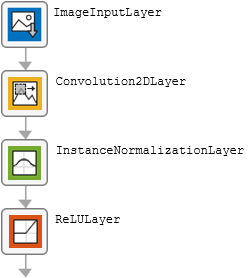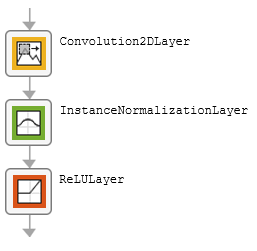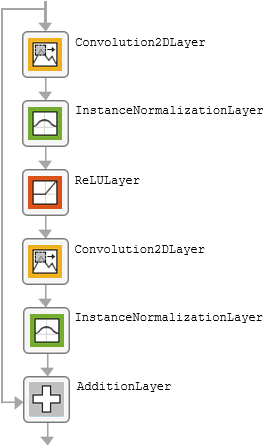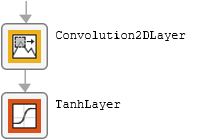addPix2PixHDLocalEnhancer
Syntax
Description
netWithEnhancer = addPix2PixHDLocalEnhancer(net)net.
For more information about the network architecture, see pix2pixHD Local Enhancer Network.
This function requires Deep Learning Toolbox™.
netWithEnhancer = addPix2PixHDLocalEnhancer(net,Name=Value)
Examples
Specify the network input size for 32-channel data of size 512-by-1024.
inputSize = [512 1024 32];
Create a pix2pixHD global generator network.
pix2pixHD = pix2pixHDGlobalGenerator(inputSize)
pix2pixHD =
dlnetwork with properties:
Layers: [84×1 nnet.cnn.layer.Layer]
Connections: [92×2 table]
Learnables: [110×3 table]
State: [0×3 table]
InputNames: {'GlobalGenerator_inputLayer'}
OutputNames: {'GlobalGenerator_fActivation'}
Initialized: 1
View summary with summary.
Add a local enhancer network to the pix2pixHD network.
pix2pixHDEnhanced = addPix2PixHDLocalEnhancer(pix2pixHD)
pix2pixHDEnhanced =
dlnetwork with properties:
Layers: [113×1 nnet.cnn.layer.Layer]
Connections: [124×2 table]
Learnables: [146×3 table]
State: [0×3 table]
InputNames: {'LocalEnhancer_inputLayer' 'GlobalGenerator_inputLayer'}
OutputNames: {'LocalEnhancer_fActivation'}
Initialized: 1
View summary with summary.
Display the network with the local enhancer.
analyzeNetwork(pix2pixHDEnhanced)
Input Arguments
Pix2pixHD generator network, specified as a dlnetwork (Deep Learning Toolbox) object. You can create a
pix2pixHD generator network using the pix2pixHDGlobalGenerator function.
Name-Value Arguments
Specify optional pairs of arguments as
Name1=Value1,...,NameN=ValueN, where Name is
the argument name and Value is the corresponding value.
Name-value arguments must appear after other arguments, but the order of the
pairs does not matter.
Example: netWithEnhancer =
addPix2PixHDLocalEnhancer(net,FilterSizeInFirstAndLastBlocks=[5 7]) adds a local
enhancer whose first and last convolution layers have a size of 5-by-7.
Before R2021a, use commas to separate each name and value, and enclose
Name in quotes.
Example: netWithEnhancer =
addPix2PixHDLocalEnhancer(net,"FilterSizeInFirstAndLastBlocks",[5 7]) adds a
local enhancer whose first and last convolution layers have a size of 5-by-7.
Filter size in the first and last convolution layers of the local enhancer network, specified as a positive odd integer or 2-element vector of positive odd integers of the form [height width]. When you specify the filter size as a scalar, the filter has equal height and width.
Filter size in intermediate convolution layers in the local enhancer network, specified as a positive odd integer or 2-element vector of positive odd integers of the form [height width]. The intermediate convolution layers are the convolution layers excluding the first and last convolution layer. When you specify the filter size as a scalar, the filter has identical height and width. Typical values are between 3 and 7.
Number of residual blocks in the local enhancer network, specified as a positive integer. Each residual block consists of a set of convolution, normalization and nonlinear layers with skip connections between every block.
Style of padding used in the local enhancer network, specified as one of these values.
PaddingValue | Description | Example |
|---|---|---|
| Numeric scalar | Pad with the specified numeric value |
|
"symmetric-include-edge" | Pad using mirrored values of the input, including the edge values |
|
"symmetric-exclude-edge" | Pad using mirrored values of the input, excluding the edge values |
|
"replicate" | Pad using repeated border elements of the input |
|
Method used to upsample activations in the local enhancer network, specified as one of these values:
"transposedConv"— Use atransposedConv2dLayer(Deep Learning Toolbox) with a stride of [2 2]"bilinearResize"— Use aconvolution2dLayer(Deep Learning Toolbox) with a stride of [1 1] followed by aresize2dLayerwith a scale of [2 2]"pixelShuffle"— Use aconvolution2dLayer(Deep Learning Toolbox) with a stride of [1 1] followed by adepthToSpace2dLayerwith a block size of [2 2]
Data Types: char | string
Weight initialization used in convolution layers of the local enhancer network,
specified as "glorot", "he",
"narrow-normal", or a function handle. For more information, see
Specify Custom Weight Initialization Function (Deep Learning Toolbox).
Activation function to use in the local enhancer network, specified as one of these values. For more information and a list of available layers, see Activation Layers (Deep Learning Toolbox).
"relu"— Use areluLayer(Deep Learning Toolbox)"leakyRelu"— Use aleakyReluLayer(Deep Learning Toolbox) with a scale factor of 0.2"elu"— Use aneluLayer(Deep Learning Toolbox)A layer object
Normalization operation to use after each convolution in the local enhancer network, specified as one of these values. For more information and a list of available layers, see Normalization Layers (Deep Learning Toolbox).
"instance"— Use aninstanceNormalizationLayer(Deep Learning Toolbox)"batch"— Use abatchNormalizationLayer(Deep Learning Toolbox)"none"— Do not use a normalization layerA layer object
Probability of dropout in the local enhancer network, specified as a number in the
range [0, 1]. If you specify a value of 0, then the network does
not include dropout layers. If you specify a value greater than 0,
then the network includes a dropoutLayer (Deep Learning Toolbox)
in each residual block.
Prefix to all layer names in the local enhancer network, specified as a string or character vector.
Data Types: char | string
Output Arguments
Pix2pixHD generator network with local enhancer, returned as a dlnetwork (Deep Learning Toolbox) object.
More About
The addPix2PixHDLocalEnhancer function performs
these operations to add a local enhancer network to a pix2pixHD global generator network.
The default enhanced network follows the architecture proposed by Wang et. al. References.
The local enhancer network has an initial block of layers that accepts images of size [2*H 2*W C], where H is the height, W is the width, and C is the number of channels of the input to the global generator network,
net. Whennethas multiple image input layers, the input image size of the local enhancer network is twice the input size with the maximum resolution.After the initial block, the local enhancer network has a single downsampling block that downsamples the data by a factor of two. Therefore, the output after downsampling has size [H W 2*C].
The
addPix2PixHDLocalEnhancerfunction trims the final block from the global generator network. The function then adds the output of the last upsampling block in the global generator network to the output of the downsampled data from the enhancer network using anadditionLayer(Deep Learning Toolbox).The output of the addition then passes through
NumResidualBlocksresidual blocks from the local enhancer.The residual blocks are followed by a single upsampling block that upsamples data to size [2*H 2*W C].
The
addPix2PixHDLocalEnhancerfunction adds a final block to the enhanced network. The convolution layer has properties specified by the arguments ofaddPix2PixHDLocalEnhancer. If the global generator network has a final activation layer, then the function adds the same type of activation layer to the enhanced network.
The table describes the blocks of layers that comprise the local enhancer network.
| Block Type | Layers | Diagram of Default Block |
|---|---|---|
| Initial block |
|
|
| Downsampling block |
|
|
| Residual block |
|
|
| Upsampling block |
|
|
| Final block |
|
|
References
[1] Wang, Ting-Chun, Ming-Yu Liu, Jun-Yan Zhu, Andrew Tao, Jan Kautz, and Bryan Catanzaro. "High-Resolution Image Synthesis and Semantic Manipulation with Conditional GANs." In 2018 IEEE/CVF Conference on Computer Vision and Pattern Recognition, 8798–8807. Salt Lake City, UT, USA: IEEE, 2018. https://doi.org/10.1109/CVPR.2018.00917.
Version History
Introduced in R2021a
See Also
Topics
MATLAB Command
You clicked a link that corresponds to this MATLAB command:
Run the command by entering it in the MATLAB Command Window. Web browsers do not support MATLAB commands.
Web サイトの選択
Web サイトを選択すると、翻訳されたコンテンツにアクセスし、地域のイベントやサービスを確認できます。現在の位置情報に基づき、次のサイトの選択を推奨します:
また、以下のリストから Web サイトを選択することもできます。
最適なサイトパフォーマンスの取得方法
中国のサイト (中国語または英語) を選択することで、最適なサイトパフォーマンスが得られます。その他の国の MathWorks のサイトは、お客様の地域からのアクセスが最適化されていません。
南北アメリカ
- América Latina (Español)
- Canada (English)
- United States (English)
ヨーロッパ
- Belgium (English)
- Denmark (English)
- Deutschland (Deutsch)
- España (Español)
- Finland (English)
- France (Français)
- Ireland (English)
- Italia (Italiano)
- Luxembourg (English)
- Netherlands (English)
- Norway (English)
- Österreich (Deutsch)
- Portugal (English)
- Sweden (English)
- Switzerland
- United Kingdom (English)




